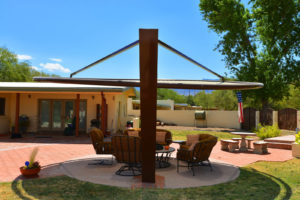A custom shade disc transforms a scorching residential backyard into a shady oasis.

In the arid Southwest, a little shade can go a long way toward transforming a residential backyard from a scorching desert to a shady oasis.
One Tucson, Ariz., couple decided to shade their yard in style by installing a custom cantilevered shade disc over their new patio.
Conrad Masterson, Owner of Shade Industries of Phoenix, Ariz., took on this unique project with enthusiasm. “The customers envisioned a round patio area for their remodeled backyard, and they wanted the area to be well-shaded,” Masterson says. “We went through some different options like shade sails, but no conventional shade options were round, and they wanted something more unique. We started talking about customized solutions, and the idea of The Discus came from that.”
The Discus is a cantilevered awning, 20 feet in diameter, supported by a 12-inch square tube and laced to a 5-foot round tube. The structure is cantilevered on only one side, creating a unique look. To provide maximum shade, the structure is angled toward the west; entry height was kept low at 6 ft. 8 in. and rises to 8 ft.
 “This project began with us asking where they wanted shade, and at what time of day they wanted it,” Masterson says. This affected the project pitch and placement.”
“This project began with us asking where they wanted shade, and at what time of day they wanted it,” Masterson says. This affected the project pitch and placement.”
Masterson relied on Commercial 95 from Gale Pacific Ltd. Commercial 95 is a knitted polyethelene (PE) shade fabric prepared with a highly durable waterproof coating. The fabric has a number of other qualities that made it a good fit for this project: it lays flat for ease of fabrication, it won’t rot or absorb moisture, it is made from 100-percent recycled material, is hot air/wedge weldable, the LDPE coating provides exceptional adhesion to the knitted substrate, and the coated side of the fabric has a 5-year UV warranty.
“We used Wholesale Shade of San Marcos, Calif., for the fabrication of the fabric element,” Masterson says. “They helped ensure that the sizing would compensate for stretch and tensioning of the fabric during installation.”
Safe installation of the structure required intricate engineering. “When we began to think through the real process of installing The Discus, we worked with our engineer to ensure that the steel sizes, footers, and anchors were going to be appropriate and hold up to normal wind loads,” Masterson says. “The Discus is engineered to withstand 90-mph winds.”
 To achieve those standards, two cubic yards of concrete were installed below grade as a footer for the structure. Once the steel was installed, the fabric was sewn to size and mounted inside Masterson’s shop to make sure the fabric fit properly.
To achieve those standards, two cubic yards of concrete were installed below grade as a footer for the structure. Once the steel was installed, the fabric was sewn to size and mounted inside Masterson’s shop to make sure the fabric fit properly.
“We decided to use a lace-on panel,” he says. “This kept all of the hardware hidden, as the No. 2 brass grommets were sewn every 7-inches into the webbing-reinforced border of the fabric’s edge. We then welded a half-inch diameter lace rail to the steel structure and laced the fabric to the structure with stainless steel cord.”
Aside from a reach fork used to mount the steel circle onto the cantilever, the installation of The Discus was done by hand with a three-person crew, including the tensioning of the fabric, over five days.
The Discus provides a new focal point, and allows the customers to frequent the patio in the comfort of shade.
Jake Kulji, a freelance writer from Shafer, Minn., is a frequent contributor to Fabric Architecture.
 TEXTILES.ORG
TEXTILES.ORG


